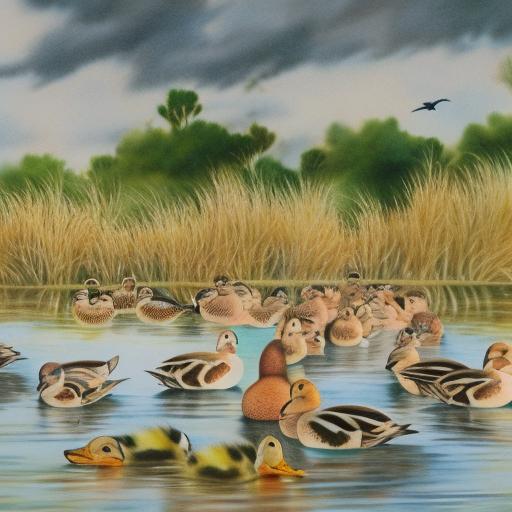Duck breeding is the process of mating ducks to produce offspring for various purposes, such as meat, eggs, or as pets. Understanding the basics of duck breeding is essential for successful reproduction and raising healthy ducklings. Ducks are known for their high fertility rates and can produce a large number of offspring in a single breeding season. It’s important to understand the natural breeding behavior of ducks, as well as the different breeds and their specific breeding characteristics.
Ducks are known for their monogamous mating behavior, where a male and female pair up and remain together for the breeding season. They are also known for their strong maternal instincts, with female ducks being excellent mothers to their ducklings. Understanding these natural behaviors can help breeders create the right breeding environment and manage the breeding process effectively. Additionally, knowing the specific breeding characteristics of different duck breeds can help breeders select the right breeding stock and optimize their breeding program for specific goals, whether it’s meat production, egg-laying, or breeding for specific traits.
Key Takeaways
- Understanding Duck Breeding:
- Ducks reach sexual maturity at around 5-7 months old and can lay eggs for up to 8 years.
- Selecting Breeding Stock:
- Choose ducks with good health, strong genetics, and desirable traits for breeding.
- Creating the Right Breeding Environment:
- Provide a clean and spacious area with access to water for breeding ducks.
- Managing Duck Breeding:
- Monitor the breeding ducks for signs of aggression, illness, or injury and provide proper nutrition.
- Incubating Duck Eggs:
- Maintain a consistent temperature and humidity level while turning the eggs multiple times a day.
- Caring for Ducklings:
- Keep the ducklings warm, dry, and well-fed with a balanced diet.
- Selling Ducklings:
- Advertise and market the ducklings to potential buyers, ensuring proper care and handling during transportation.
Selecting Breeding Stock
Selecting the right breeding stock is crucial for successful duck breeding. Breeding stock refers to the ducks that are chosen for mating to produce offspring. When selecting breeding stock, breeders should consider various factors such as health, genetics, and conformation. It’s important to choose ducks that are healthy, free from genetic defects, and have desirable physical traits that align with the breeder’s goals.
Health is a critical factor when selecting breeding stock, as healthy ducks are more likely to produce healthy offspring. Breeders should look for ducks that are active, alert, and free from any signs of illness or disease. Genetics also play a significant role in breeding stock selection, as breeders should aim to select ducks with desirable genetic traits that can be passed on to their offspring. This may include traits such as good egg-laying ability, fast growth rates, or specific color patterns. Conformation, or the physical structure of the duck, is another important consideration when selecting breeding stock. Breeders should look for ducks with good body conformation, strong legs, and well-developed reproductive systems.
Creating the Right Breeding Environment
Creating the right breeding environment is essential for successful duck breeding. The breeding environment includes the housing, nesting areas, and overall management practices that support the natural breeding behavior of ducks. Ducks require a safe and comfortable environment to engage in natural mating behaviors and to raise their offspring. When creating the right breeding environment, breeders should consider factors such as housing design, nesting areas, and access to water.
The housing for breeding ducks should provide protection from predators and the elements while allowing for natural mating behaviors to occur. Nesting areas should be designed to provide privacy and security for nesting females, as well as easy access for egg collection. Access to water is also important for ducks, as they are aquatic birds that enjoy swimming and mating in water. Providing a clean and accessible water source can encourage natural mating behaviors and support overall duck health. Additionally, managing the breeding environment includes providing proper nutrition, monitoring health, and minimizing stress factors that can impact breeding success.
Managing Duck Breeding
Managing duck breeding involves overseeing the entire breeding process from mating to hatching and raising ducklings. This includes monitoring breeding behavior, ensuring proper nutrition, and providing necessary care to support successful reproduction. Breeders should observe mating behaviors to ensure that ducks are successfully pairing up and mating. This may involve separating pairs into breeding groups or providing opportunities for natural mating behaviors to occur.
Proper nutrition is essential for successful duck breeding, as ducks require a balanced diet to support reproductive health and egg production. Breeders should provide a high-quality feed that meets the nutritional needs of breeding ducks, including essential vitamins and minerals. Additionally, providing access to clean water and supplemental nutrients can support overall reproductive success. Monitoring health is also crucial in managing duck breeding, as any signs of illness or disease can impact fertility and hatchability. Regular health checks and prompt veterinary care can help maintain optimal reproductive health in breeding ducks.
Incubating Duck Eggs
Incubating duck eggs is a critical step in the duck breeding process, as it allows for the hatching of fertile eggs into healthy ducklings. Incubation involves maintaining optimal temperature and humidity levels to support embryo development within the eggs. Duck eggs typically require an incubation period of around 28 days before hatching. When incubating duck eggs, breeders should use a reliable incubator that can maintain consistent temperature and humidity levels throughout the entire incubation period.
The temperature for incubating duck eggs should be around 99.5 degrees Fahrenheit, with slight variations allowed during different stages of incubation. Humidity levels should be maintained at around 55-60% during the first 25 days of incubation and increased to 65-70% during the final three days before hatching. Turning the eggs several times a day during the first 25 days is also important to ensure proper embryo development. Breeders should monitor the incubation process closely, regularly checking temperature and humidity levels to ensure optimal conditions for embryo development.
Caring for Ducklings

Caring for ducklings involves providing proper nutrition, housing, and overall care to support their growth and development. Ducklings require a warm and safe environment to thrive, as well as a balanced diet to support their nutritional needs. When caring for ducklings, breeders should provide a brooder area with a heat source to maintain optimal temperature levels for young ducklings. This may include using heat lamps or brooder heaters to create a warm and comfortable environment.
Proper nutrition is essential for growing ducklings, as they require a high-quality feed that meets their specific nutritional needs. Ducklings should be provided with a starter feed that contains essential nutrients such as protein, vitamins, and minerals to support healthy growth and development. Additionally, access to clean water is crucial for ducklings, as they need to stay hydrated and maintain overall health. Providing proper housing that protects ducklings from predators and the elements is also important for their safety and well-being.
Selling Ducklings
Selling ducklings is an important aspect of duck breeding for breeders who wish to sell offspring for various purposes such as meat production or as pets. When selling ducklings, breeders should consider factors such as marketing strategies, customer relationships, and legal regulations related to selling poultry. Developing effective marketing strategies can help breeders reach potential customers and promote their ducklings for sale.
Building strong customer relationships is also important when selling ducklings, as satisfied customers are more likely to return for future purchases and recommend the breeder to others. Providing excellent customer service and maintaining open communication with customers can help build trust and loyalty within the market. Additionally, breeders should be aware of legal regulations related to selling poultry, including any permits or licenses required for selling ducklings in their area.
In conclusion, understanding the basics of duck breeding, selecting the right breeding stock, creating the right breeding environment, managing the breeding process effectively, incubating duck eggs, caring for ducklings, and selling ducklings are all essential components of successful duck breeding. By following best practices in each of these areas, breeders can optimize their breeding program and raise healthy ducklings for various purposes.
If you’re interested in breeding ducks, you may also want to consider the importance of providing the right environment for your poultry. A well-designed chicken coop can make a significant difference in the health and productivity of your birds. In fact, an article on PoultryWizard.com discusses the optimal size for a chicken coop door, offering valuable insights into creating a comfortable and secure space for your ducks. Check out the article here to learn more about this essential aspect of poultry care.
FAQs
What is duck breeding?
Duck breeding refers to the process of mating ducks in order to produce offspring. This can be done for various purposes such as meat production, egg production, or for ornamental purposes.
What are the different methods of breeding ducks?
There are several methods of breeding ducks, including natural mating, artificial insemination, and using incubators to hatch eggs. Natural mating is the most common method, where ducks are allowed to mate naturally. Artificial insemination is used in cases where natural mating is not possible or to control breeding for specific traits. Incubators are used to hatch duck eggs in a controlled environment.
What are the factors to consider when breeding ducks?
When breeding ducks, it is important to consider factors such as the breed of ducks, their age, health, and nutrition. Proper housing and nesting facilities should also be provided to ensure successful breeding.
How long does it take for duck eggs to hatch?
Duck eggs typically take around 28 days to hatch. However, this can vary slightly depending on the breed of duck and the specific incubation conditions.
What are some common duck breeding problems?
Common duck breeding problems include infertility, poor egg production, and difficulties in hatching. These issues can be caused by factors such as inadequate nutrition, improper breeding conditions, or health issues in the ducks.
What are some popular duck breeds for breeding?
Popular duck breeds for breeding include Pekin, Khaki Campbell, Indian Runner, and Muscovy ducks. These breeds are known for their good egg production, meat quality, or ornamental value.
Meet Walter, the feathered-friend fanatic of Florida! Nestled in the sunshine state, Walter struts through life with his feathered companions, clucking his way to happiness. With a coop that’s fancier than a five-star hotel, he’s the Don Juan of the chicken world. When he’s not teaching his hens to do the cha-cha, you’ll find him in a heated debate with his prized rooster, Sir Clucks-a-Lot. Walter’s poultry passion is no yolk; he’s the sunny-side-up guy you never knew you needed in your flock of friends!







